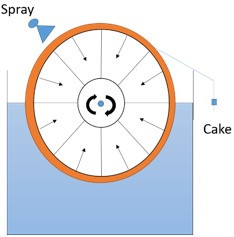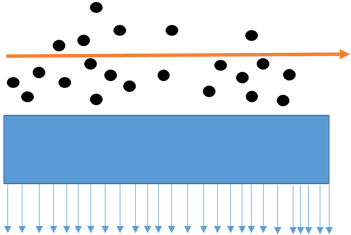This set of Enzyme Technology Multiple Choice Questions & Answers (MCQs) focuses on “Enzymes Purification – Ultrafiltration”.
1. Which of the following technique uses separation on the basis of particle size?
a) Chromatography
b) Ultrasonication
c) Homogenization
d) Filtration
View Answer
Explanation: The technique which separates on the basis of particle size is filtration. The efficiency is limited by shape and compressibility of the particles, the viscosity of the liquid and maximum allowable pressures. Ultrasonication and homogenization are the physical extraction methods to pump out the cell contents for further purification. Chromatography is a step involved in purification.
2. Which of the following is not employed for filtration?
a) Filter cloth
b) Plate and frame press
c) Homogenizer
d) Rotary vacuum filter
View Answer
Explanation: Filtration is a technique which separates based on the particle size. Filter cloth, rotary vacuum filter and filter cloth and filter aid in plate and frame press configuration are employed in filtration. Homogenizer is not used for filtration, but homogenization which is a technique used to mechanically break open the cell to free its contents for purification.
3. Filter aids are generally used where the liquid phase is required.
a) True
b) False
View Answer
Explanation: In filtration, particles that are easily compressed lead to filter blockage and failure of the system. To overcome this, filter aids are used. These are generally used where the liquid phase is required because they cause lot of problems in recovering the solids. It may also cause loss enzyme activity due to physically held up in the filter cake.
4. The process in which high tangential flow of feedstock across the surface of the filter is achieved to avoid the problems of buildup of filter cake is known as ____________
a) crossflow microfiltration
b) filtration
c) ultrafiltration
d) rotary vacuum filter
View Answer
Explanation: To avoid the problems of buildup of filter cake, the crossflow microfiltration was developed. This process allows high tangential flow of feedstock across the surface of the filter. Filtration is a separation technique which separates based on the particle size. Ultrafiltration is a type of crossflow microfiltration technology. Rotary vacuum filter is used for continuous filtration.
5. Pharmaceutical industry employs _____________ in order to recycle flow or add value to later products.
a) plate and frame press
b) ultrafiltration
c) filtration
d) chromatography
View Answer
Explanation: Ultrafiltration is a type of crossflow microfiltration which is done by pressurizing the solution flow, which is tangential to the surface of the supported membrane. In industries such as pharmaceutical, chemical, food and beverage processing and waste water treatment, ultrafiltration is employed in order to recycle flow or add value to later products. Filtration is a technique for separation of molecules based on its size. Plate and frame press is a machinery used for filtration. Chromatography a step in purification.
6. The solvent and other dissolve compounds that pass through the membrane is called __________
a) diffusate
b) retentate
c) permeate
d) filter cloth
View Answer
Explanation: In filtration, permeate is the solvent and other dissolved compounds that is passed through the membrane. The components that do not pass through the membrane are known as retentate. Filter cloth is a method employed in filtration. Diffusate is the solvent outside during dialysis.
7. Currently, ultrafiltration is mainly used at lab scale.
a) True
b) False
View Answer
Explanation: Ultrafiltration is mainly used at lab scale in current days because it is very prone to membrane fouling. This is caused due to increased solute concentration at the membrane surface, which leads to concentration polarization (CP). CP is the major culprit in decreasing permeate flux.
8. What does the following equation represents?
ϕ=\(\frac{kPA_f}{ηD_f}\)
a) Ionic strength
b) Kinetic rate constant
c) Solubility of an enzyme
d) Volumetric throughput
View Answer
Explanation: The equation represents the volumetric throughput of a filter which is proportional to Pressure (P) and filter area (Af) and inversely proportional to filter cake thickness (Df) and the dynamic viscosity (ɳ). In the equation, k is proportionality constant dependent on size and nature of the particles.
9. What does the machinery in the below diagram represent?

a) Frame and plate press
b) Ultrafiltration
c) Rotary vacuum filter
d) Homogenizer
View Answer
Explanation: The machinery in the diagram has a rotating drum with a filter cloth which is places in a suspension to be filtered. The filter cake is removed by the blade provided and the filter cake may be rinsed during rotation with the use of sprayer which spray water to clean it. Hence the machinery represents rotary vacuum filter.
10. What is the process showed in the diagram below?

a) Filtration
b) Crossflow microfiltration
c) Ultrafiltration
d) Dialysis
View Answer
Explanation: The process showed in the diagram is crossflow microfiltration. In the diagram, it is shown that the feed flow is tangential to the membrane which does not allow buildup of filter cake which may cause substantial problems in recovery of solids and loss of enzyme activity due to physical held up in the cake.
Sanfoundry Global Education & Learning Series – Enzyme Technology.
To practice all areas of Enzyme Technology, here is complete set of 1000+ Multiple Choice Questions and Answers.
If you find a mistake in question / option / answer, kindly take a screenshot and email to [email protected]
- Practice Chemical Engineering MCQs
- Practice Biotechnology MCQs
- Apply for Chemical Engineering Internship
- Check Chemical Engineering Books
- Check Biotechnology Books
